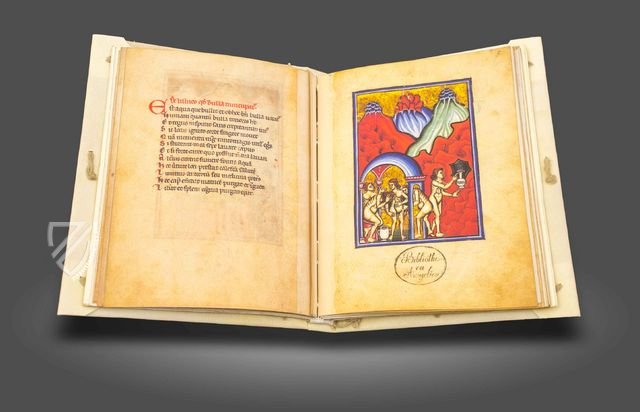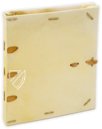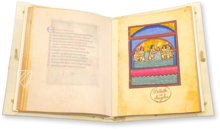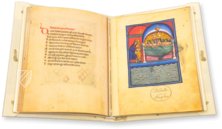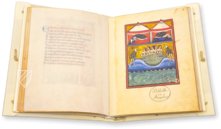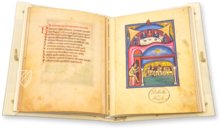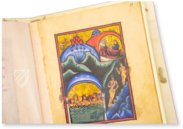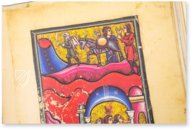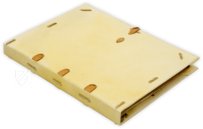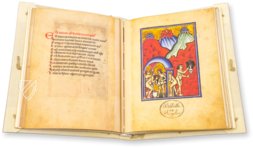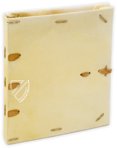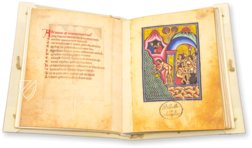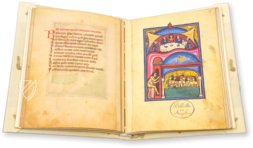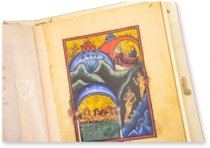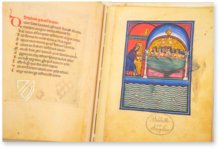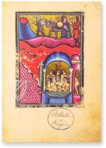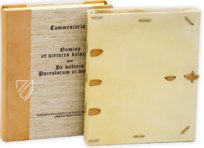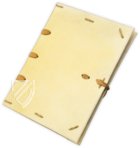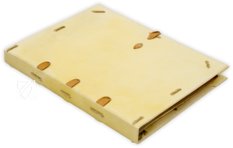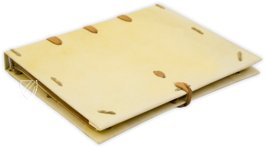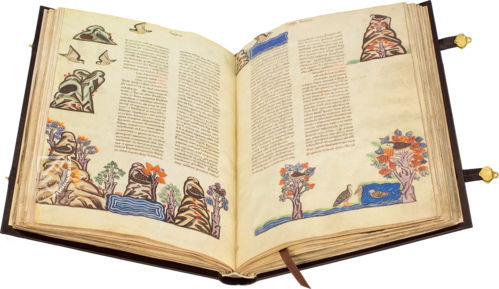De Balneis Puteolanis
(1,000€ - 3,000€)
This important copy of the famous writing "De Balneis Puteolanis" by Pietro da Eboli on the healing properties of the baths of Pozzuoli is the oldest surviving copy of the lost original by the physician and poet. The luxurious codex was written in Naples only a few years after the autograph in the mid-13th century and is a fascinating document of the beginnings of scientific medicine. The informative and entertaining didactic poem by the Italian poet is complemented here by 18 full-page and colourful miniatures, which are a unique testimony to southern Italian book illumination of the Duecento and combine the most diverse stylistic influences into small works of art. This rarity of medieval book illumination is today housed in the Biblioteca Angelica in Rome under the shelfmark Ms. 1474.
De Balneis Puteolanis
In the years 1211–21, Pietro da Eboli composed his magnum opus, both scientific and literary, with the title De Balneis Puteolanis. In doing so, he hit the nerve of his time and created a work that was widely disseminated thereafter. Thus, the work was widespread in numerous manuscripts up to the 15th century and was further disseminated upon appearing in numerous print editions thereafter. The luxurious manuscript from the Biblioteca Angelica in Rome is considered to be the oldest specimen of the now-lost original. Its style indicates that is was made in Naples in the 1250’s.
A Medically Entertaining Treatise
The treatise or didactic poem On the Baths of Pozzouli by Pietro da Eboli is an exciting and valuable testimonial to the beginnings of scientific medicine. The text is a description of 35 springs around Pozzouli on the Gulf of Naples and their medicinal curative effects and attests to the therapeutic importance of the healing baths, which have been used since antiquity as thermal baths and healing springs for medical use. In doing so, Pietro da Eboli stands in the tradition of famous ancient doctors such as Galen, Avicenna, or Hippocrates. De Balneis Puteolanis is dedicated to the Sol Mundi – Emperor Frederick II – who was himself a regular user and believer in the therapeutic powers of hot springs. Therefore, the work by Pietro da Eboli is simultaneously considered to be a reminder of therapeutic baths in 13th century Italy and a testimonial to the enthusiasm for scholarship and cultivated beauty at the imperial court.
A Luxury Manuscript with Useful Content
The precious manuscript of the Biblioteca Angelica in Rome with the shelf mark Ms. 1474 presents this work in a gorgeous setting: 18 full-page, large-format miniature pages – consistent with the 18 epigrams of the didactic poem – accompany the text. The high-quality miniatures originate from a single miniaturist and are presented in bright frames and on a gold background. These small works of art make the manuscript a significant testimonial to the south Italian illumination of the Duecento: Byzantine elements are integrated here in the realistic depictions, Roman architecture merged with oriental domed roofs and the depiction of the human body is clearly and wholly classically influence.
Codicology
- Alternative Titles
- De Balneis Puteoli
- Size / Format
- 42 pages / 18.3 × 13.0 cm
- Origin
- Italy
- Date
- Ca. 1250
- Style
- Language
- Script
- Gothic Textura
- Illustrations
- 18 full-page miniatures
- Content
- Poem describing the thermal baths of the Phlegraean Fields
- Artist / School
- Pietro da Eboli (author)
De Balneis Puteolanis
Sauna at Agnano
Saunas are valued today for their health benefits and having a good sweat in the heat of a sauna is also supposed to help with inflammation and has other health benefits. Here we see a man exiting the sauna to receive some water from a river, which has frogs and snakes swimming around it. Inside the sauna, a group of nude men is assembled around an iron cauldron, which is probably filled with heated rocks that the water from the river will be poured on.
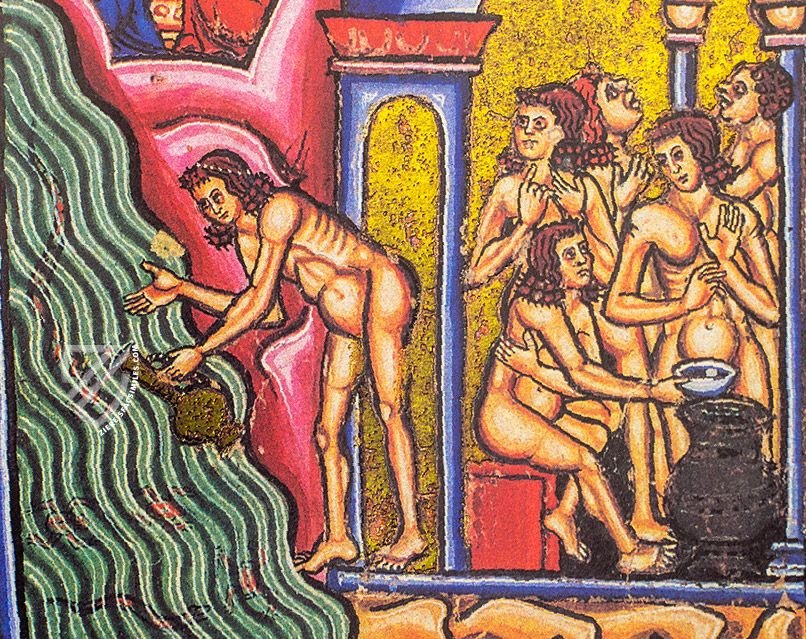
De Balneis Puteolanis
Bathing in a Cave
Of the 35 hot springs around Pozzouli on the Gulf of Naples detailed by Pietro da Eboli, some were located in caves, such as the Balneum Culmae (pictured here). This scene shows a cave full of people enjoying the hot, healing waters bubbling up from deep in the ground – such fissures in the earth’s crust can often be found in caves, which would be usable year round.
The large number of healing thermal baths in southern Italy created a large medieval tourist industry with local rivalries arising to compete for this lucrative business. Perhaps the figures rowing by on a boat outside of the cave are tourists. Aside from the gold leaf walls of the cave, which have flaked and peeled off, the rest of the miniature is in excellent condition.
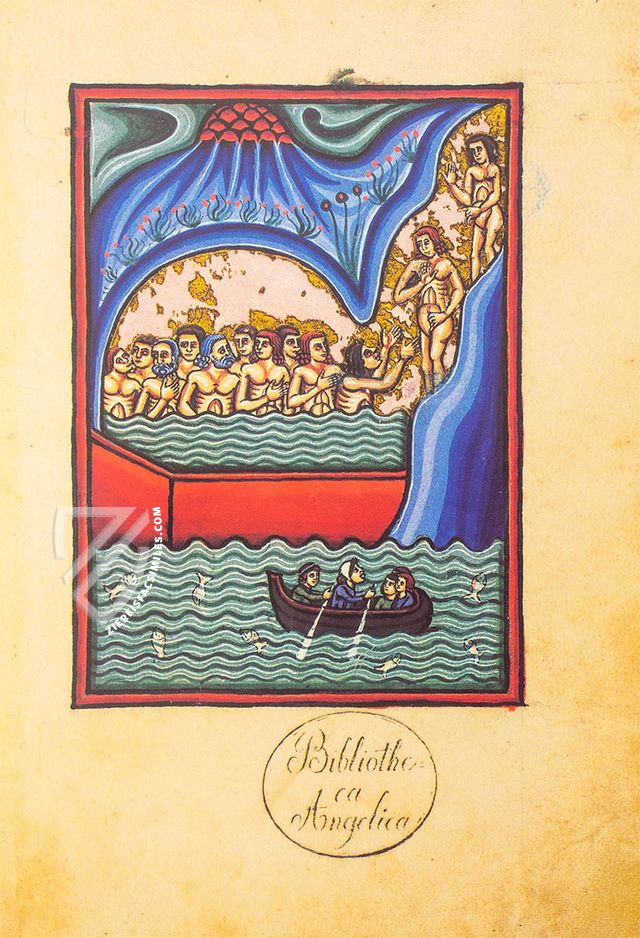
#1 De Balneis Puteolanis
Language: Italian
(1,000€ - 3,000€)
- Treatises / Secular Books
- Apocalypses / Beatus
- Astronomy / Astrology
- Bestiaries
- Bibles / Gospels
- Chronicles / History / Law
- Geography / Maps
- Saints' Lives
- Islam / Oriental
- Judaism / Hebrew
- Single Leaf Collections
- Leonardo da Vinci
- Literature / Poetry
- Liturgical Manuscripts
- Medicine / Botany / Alchemy
- Music
- Mythology / Prophecies
- Psalters
- Other Religious Books
- Games / Hunting
- Private Devotion Books
- Other Genres
- Afghanistan
- Armenia
- Austria
- Belgium
- Colombia
- Croatia
- Cyprus
- Czech Republic
- Denmark
- Egypt
- Ethiopia
- France
- Germany
- Greece
- Hungary
- India
- Iran
- Iraq
- Israel
- Italy
- Japan
- Lebanon
- Luxembourg
- Mexico
- Morocco
- Netherlands
- Palestine
- Peru
- Poland
- Portugal
- Russia
- Serbia
- Spain
- Sri Lanka
- Sweden
- Switzerland
- Syria
- Turkey
- Ukraine
- United Kingdom
- United States
- Uzbekistan
- Aboca Museum
- Ajuntament de Valencia
- Akademie Verlag
- Akademische Druck- u. Verlagsanstalt (ADEVA)
- Aldo Ausilio Editore - Bottega d’Erasmo
- Alecto Historical Editions
- Alkuin Verlag
- Almqvist & Wiksell
- Amilcare Pizzi
- Andreas & Andreas Verlagsbuchhandlung
- Archa 90
- Archiv Verlag
- Archivi Edizioni
- Arnold Verlag
- ARS
- Ars Magna
- ArtCodex
- AyN Ediciones
- Azimuth Editions
- Badenia Verlag
- Bärenreiter-Verlag
- Belser Verlag
- Belser Verlag / WK Wertkontor
- Benziger Verlag
- Bernardinum Wydawnictwo
- BiblioGemma
- Biblioteca Apostolica Vaticana (Vaticanstadt, Vaticanstadt)
- Bibliotheca Palatina Faksimile Verlag
- Bibliotheca Rara
- Boydell & Brewer
- Bramante Edizioni
- Bredius Genootschap
- Brepols Publishers
- British Library
- C. Weckesser
- Caixa Catalunya
- Canesi
- CAPSA, Ars Scriptoria
- Caratzas Brothers, Publishers
- Carus Verlag
- Casamassima Libri
- Chavane Verlag
- Christian Brandstätter Verlag
- Circulo Cientifico
- Club Bibliófilo Versol
- Club du Livre
- CM Editores
- Collegium Graphicum
- Collezione Apocrifa Da Vinci
- Comissão Nacional para as Comemorações dos Descobrimentos Portugueses
- Coron Verlag
- Corvina
- CTHS
- D. S. Brewer
- Damon
- De Agostini/UTET
- De Nederlandsche Boekhandel
- De Schutter
- Deuschle & Stemmle
- Deutscher Verlag für Kunstwissenschaft
- DIAMM
- Droz
- E. Schreiber Graphische Kunstanstalten
- Ediciones Boreal
- Ediciones Grial
- Ediclube
- Edições Inapa
- Edilan
- Editalia
- Edition Deuschle
- Edition Georg Popp
- Edition Leipzig
- Edition Libri Illustri
- Editiones Reales Sitios S. L.
- Éditions de l'Oiseau Lyre
- Editions Medicina Rara
- Editorial Casariego
- Editorial Mintzoa
- Editrice Antenore
- Editrice Velar
- Edizioni Edison
- Egeria, S.L.
- Eikon Editores
- Electa
- Emery Walker Limited
- Enciclopèdia Catalana
- Eos-Verlag
- Ephesus Publishing
- Ernst Battenberg
- Eugrammia Press
- Extraordinary Editions
- Fackelverlag
- Facsimila Art & Edition
- Facsimile Editions Ltd.
- Facsimilia Art & Edition Ebert KG
- Faksimile Verlag
- Feuermann Verlag
- Folger Shakespeare Library
- Franco Cosimo Panini Editore
- Friedrich Wittig Verlag
- Fundación Hullera Vasco-Leonesa
- G. Braziller
- Gabriele Mazzotta Editore
- Gebr. Mann Verlag
- Gesellschaft für graphische Industrie
- Getty Research Institute
- Giovanni Domenico de Rossi
- Giunti Editore
- Graffiti
- Grafica European Center of Fine Arts
- Guido Pressler
- Guillermo Blazquez
- Gustav Kiepenheuer
- H. N. Abrams
- Harrassowitz
- Helikon
- Hendrickson Publishers
- Henning Oppermann
- Herder Verlag
- Hes & De Graaf Publishers
- Hoepli
- Holbein-Verlag
- Hortus Deliciarum
- Houghton Library
- Hugo Schmidt Verlag
- Idion Verlag
- Il Bulino, edizioni d'arte
- ILte
- Imago
- Insel Verlag
- Instituto Nacional de Antropología e Historia
- Istituto dell'Enciclopedia Italiana - Treccani
- Istituto Ellenico di Studi Bizantini e Postbizantini
- Istituto Geografico De Agostini
- Istituto Poligrafico e Zecca dello Stato
- Italarte Art Establishments
- J. Thorbecke
- Jan Thorbecke Verlag
- Johnson Reprint Corporation
- Josef Stocker
- Josef Stocker-Schmid
- Jugoslavija
- Karl W. Hiersemann
- Kasper Straube
- Kaydeda Ediciones
- Kindler Verlag / Coron Verlag
- Kodansha International Ltd.
- Konrad Kölbl Verlag
- Kurt Wolff Verlag
- La Liberia dello Stato
- La Linea Editrice
- La Meta Editore
- Lambert Schneider
- Landeskreditbank Baden-Württemberg
- Leo S. Olschki
- Les Incunables
- Library of Congress
- Libreria Musicale Italiana
- Lichtdruck
- Lito Immagine Editore
- Lumen Artis
- Lund Humphries
- M. Moleiro Editor
- Maison des Sciences de l'homme et de la société de Poitiers
- Manuscriptum
- Martinus Nijhoff
- Maruzen-Yushodo Co. Ltd.
- MASA
- McGraw-Hill
- Militos
- Millennium Liber
- Müller & Schindler
- Nahar and Steimatzky
- National Library of Wales
- Neri Pozza
- Nova Charta
- Oceanum Verlag
- Odeon
- Orbis Mediaevalis
- Orbis Pictus
- Österreichische Staatsdruckerei
- Oxford University Press
- Pageant Books
- Parzellers Buchverlag
- Patrimonio Ediciones
- Pattloch Verlag
- PIAF
- Pieper Verlag
- Plon-Nourrit et cie
- Prestel Verlag
- Princeton University Press
- Prisma Verlag
- Priuli & Verlucca, editori
- Pro Sport Verlag
- Propyläen Verlag
- Pytheas Books
- Quaternio Verlag Luzern
- Reales Sitios
- Recht-Verlag
- Reichert Verlag
- Reichsdruckerei
- Riehn & Reusch
- Roberto Vattori Editore
- Rosenkilde and Bagger
- Roxburghe Club
- Salerno Editrice
- Sarajevo Svjetlost
- Schöck ArtPrint Kft.
- Scolar Press
- Scrinium
- Scripta Maneant
- Scriptorium
- Siloé, arte y bibliofilia
- SISMEL - Edizioni del Galluzzo
- Sociedad Mexicana de Antropología
- Société des Bibliophiles & Iconophiles de Belgique
- Soncin Publishing
- Sorli Ediciones
- Stainer and Bell
- Studer
- Styria Verlag
- Sumptibus Pragopress
- Szegedi Tudomànyegyetem
- Taberna Libraria
- Tarshish Books
- Taschen
- Tempus Libri
- Testimonio Compañía Editorial
- Thames and Hudson
- The Clear Vue Publishing Partnership Limited
- The Facsimile Codex
- The Folio Society
- The Marquess of Normanby
- The Richard III and Yorkist History Trust
- Tip.Le.Co
- TouchArt
- TREC Publishing House
- TRI Publishing Co.
- Trident Editore
- Typis Regiae Officinae Polygraphicae
- Union Verlag Berlin
- Universidad de Granada
- University of California Press
- University of Chicago Press
- Urs Graf
- Vallecchi
- Van Wijnen
- VCH, Acta Humaniora
- VDI Verlag
- VEB Deutscher Verlag für Musik
- Verlag Anton Pustet / Andreas Verlag
- Verlag Bibliophile Drucke Josef Stocker
- Verlag der Münchner Drucke
- Verlag für Regionalgeschichte
- Verlag Styria
- Vicent Garcia Editores
- W. Turnowsky
- Waanders Printers
- Wiener Mechitharisten-Congregation (Wien, Österreich)
- Wissenschaftliche Buchgesellschaft
- Wydawnictwo Dolnoslaskie
- Xuntanza Editorial
- Zakład Narodowy
- Zollikofer AG

